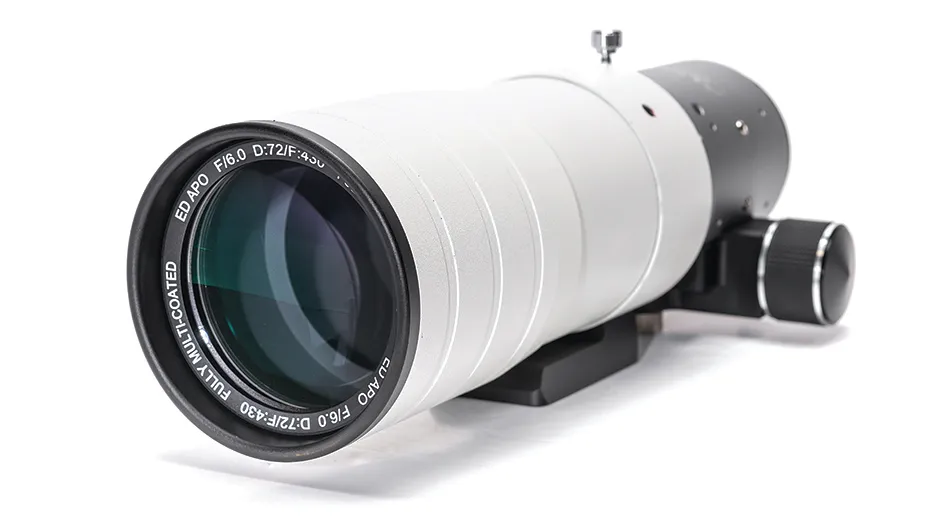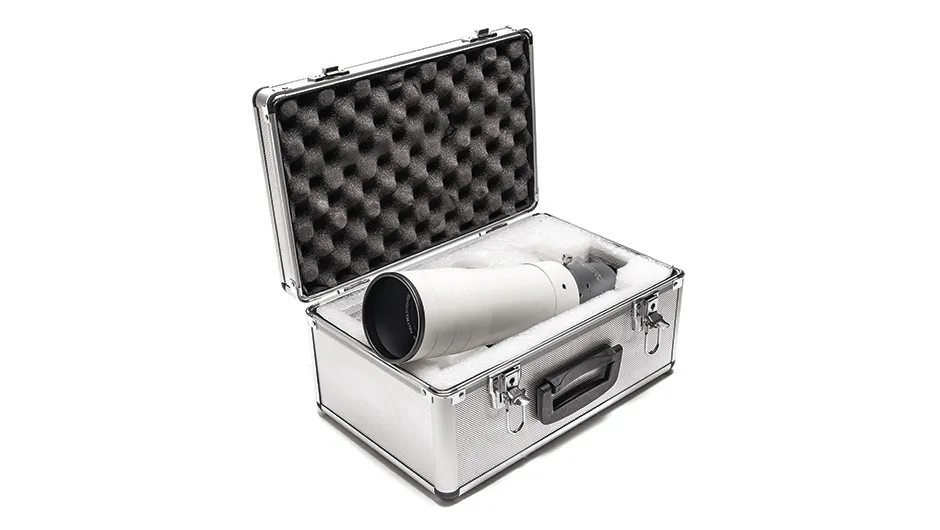Price: £369.00
Aperture: 72mm (2.8 inches)
Focal Length: 430mm (f/6)
Weight: 2.5kg
Supplier: Altair Astro
Telephone: 01263 731505
Website: www.altairastro.com
In an attempt to beat light pollution many astronomers travel away from their gardens to sites with darker skies, so there is much demand for high quality yet portable telescopes.
Altair’s Lightwave 72ED-R refractor aims to provide just that.
With its 2.8-inch aperture, relative lightness and diminutive size, this really is a grab and go telescope.
It weighs just 2.5kg, placing minimal demands on small mounts.
Better yet, it is supplied with a stylish aluminium case measuring just 39x25x19cm.
Note, however, that it is not packaged with a star diagonal or any eyepieces.
The telescope tube’s textured cream finish contrasts well with the unusual silver of the rack and pinion focuser, which has a 10:1 slow motion drive.
Fit and finish are excellent, and should it ever be necessary the focuser can be collimated.
Although it has is no lock, the extendable dew shield has a smooth friction fit that holds it in place even when pointing vertically.
The focuser was smooth in operation and once locked in focus it held our relatively heavy CCD camera (1.66kg) with no slippage.
However, focusing when using the 10:1 reduction knob required a combination of unlocking the tube clamp, making a small adjustment and then relocking before releasing the focus knob.
Once locked, focus remained solid during our extended imaging sessions.
We were unable to obtain balance in the declination axis with our imaging equipment in place, as the built-in mounting foot was too short to allow adequate movement.
However, we bolted the foot to our own Losmandy style dovetail bar using the two 1/4-20 tripod bushes set into the base of the foot, and this resolved the issue.

A wide field of view
The Lightwave 72ED-R’s focal length of 430mm places it firmly into the wide-field category when it comes to imaging deep-sky objects.
To put this into some kind of perspective, using a DSLR camera with its typical APS C sensor yields a field of view a fraction under 3° by 2°.
This is enough to capture the entirety of the North America Nebula or the Veil Nebula in Cygnus.
However, you can use a focal reducer-field flattener to correct field curvature, which will widen the field of view further.
Early evening provided the best observing conditions during the review period and we enjoyed some great deep-sky views before the Moon made an appearance.
The Ring Nebula in Lyra was tiny but perfectly visible, and the colour-contrasting stars that comprise the double of Albireo showed very nicely indeed.
The Pleiades star cluster was a wonderful sight in our 17mm eyepiece at 25x magnification and star shapes remained good out to about 85 per cent of the field of view.
A tiny amount of chromatic aberration was just visible on the Moon’s limb but this was quite well controlled.
Fighting field curvature
Imaging the Pleiades with our own one shot colour CCD camera confirmed that chromatic aberration was minimal.
In common with most refractors, we found the field curvature intrusive, resulting in elongated stars at the edges of the field of view of our shots.
We also imaged the Eastern Veil Nebula in hydrogen-alpha, this time with our own focal reducer-field flattener to flatten the field: this delivered a good improvement, though it was still not perfect.
Some vignetting was visible, but was resolved through image processing using a set of flat calibration frames.
We very much enjoyed using this telescope as it was easy to operate and delivered some memorable views.
Its diminutive size, wide field of view, solid construction and good optics make it an excellent travelling companion, and its imaging capabilities only add to its usefulness.
We would recommend the Lightwave 72ED-R as a grab and go instrument and to beginners starting out on their imaging journey.

The right focuser for astro imaging
Until recently, small refractors such as the Lightwave 72ED-R were supplied with Crayford focusers – which give excellent focus action with no backlash and are ideal for observations with an eyepiece.
However, Crayfords do have an Achilles heel in that they are often not able to support the additional weight of photographic equipment reliably.
The Lightwave 72ED-R is supplied with a rack and pinion focuser that can be rotated and collimated, has a very smooth action, and yet is capable of supporting the weight of astrophotography equipment.
This smooth and backlash-free system is achieved by the use of a helical gear system in which the teeth are set at an angle to the side of the gear, as opposed to being at right angles.
This design increases the contact ratio (the number of teeth engaged), which in turn increases the load-bearing capability.
The substantial, baffled 2.5-inch focus tube has a very generous 97mm of movement with a 10:1 reduction drive, an etched scale and anti-marring eyepiece compression rings for both 2- and 1.25-inch eyepieces.
Retractable Dew Shield
The friction-fit retractable dew shield offers good protection from stray light.
Its interior is finished in very matt black paint to keep reflections to a minimum and increase contrast.
With an internal diameter of 85mm and an extension of 75mm in front of the primary lens, it also helps to reduce dewing.
ED glass doublet
The lens in this telescope is an air-spaced doublet, one element of which is made from ED (extra-low dispersion) glass.
With a focal length of 430mm, this f/6 doublet gives a wide field of view for both observing and astrophotography.
The lens elements are fully multicoated to increase light transmission and reduce reflections.
CNC-machined tube
The CNC-machined alloy optical tube is substantially made and finished in a textured cream powdercoat to a high standard.
Internally, there are two light baffles and the whole inside is finished in matt black paint.
A CNC-machined precision lens cell supports the front lens.
Mounting foot
This telescope doesn’t have tube rings, instead relying on a fixed L-shaped foot with a Vixen-style dovetail profile incorporating two 1/4-20 threaded holes for use with a standard photographic tripod.
In common with many similar telescopes, this was not long enough to allow proper balance adjustment with a camera attached.
Aluminium flight case
The telescope is housed in a substantial and well-padded aluminium flight case that is stylishly finished with smooth corners and nylon feet.
An accident in transit that left a large and deep hole in the floor of the case showed how well it is made, as the telescope inside escaped undamaged and arrived in good collimation.
This review originally appeared in the March 2015 issue of BBC Sky at Night Magazine.
